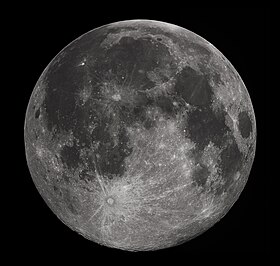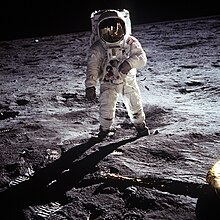 | |||||||||||||
| Designations | |||||||||||||
|---|---|---|---|---|---|---|---|---|---|---|---|---|---|
| Adjectives | lunar, selenic | ||||||||||||
| Orbital characteristics | |||||||||||||
| Perigee | 363,104 km (0.002 4 AU) | ||||||||||||
| Apogee | 405,696 km (0.002 7 AU) | ||||||||||||
| 384,399 km (0.002 57 AU[1]) | |||||||||||||
| Eccentricity | 0.054 9[1] | ||||||||||||
| 27.321 582 d (27 d 7 h 43.1 min[1]) | |||||||||||||
| 29.530 589 d (29 d 12 h 44 min 2.9 s) | |||||||||||||
Average orbital speed | 1.022 km/s | ||||||||||||
| Inclination | 5.145° to the ecliptic[1] (between 18.29° and 28.58° to Earth's equator) | ||||||||||||
| regressing by one revolution in 18.6 years | |||||||||||||
| progressing by one revolution in 8.85 years | |||||||||||||
| Satellite of | Earth | ||||||||||||
| Physical characteristics | |||||||||||||
Mean radius | 1,737.10 km (0.273 Earths)[1][2] | ||||||||||||
| Flattening | 0.001 25 | ||||||||||||
| Circumference | 10,921 km (equatorial) | ||||||||||||
| 3.793 × 107 km² (0.074 Earths) | |||||||||||||
| Volume | 2.195 8 × 1010 km³ (0.020 Earths) | ||||||||||||
| Mass | 7.347 7 × 1022 kg (0.012 3 Earths[1]) | ||||||||||||
Mean density | 3,346.4 kg/m³[1] | ||||||||||||
| 1.622 m/s² (0.165 4 g) | |||||||||||||
| 2.38 km/s | |||||||||||||
Sidereal rotation period | 27.321 582 d (synchronous) | ||||||||||||
Equatorial rotation velocity | 4.627 m/s | ||||||||||||
| 1.542 4° (to ecliptic) 6.687° (to orbit plane) | |||||||||||||
| Albedo | 0.12 | ||||||||||||
| |||||||||||||
| −2.5 to −12.9[4] −12.74 (mean full moon)[2] | |||||||||||||
| 29.3 to 34.1 arcminutes[2][5] | |||||||||||||
Surface pressure | 2.25 × 10-12 torr [6] | ||||||||||||

The Moon (Latin: luna) is Earth's satellite, and we can usually see it in the night sky. Other planets also have moons or "natural satellites".
Our moon is about a quarter the size of the Earth. Because it is far away it looks small. The gravity on the moon is one-sixth of the Earth's gravity.[8] It means that something will be six times lighter on the Moon than on Earth. The Moon is a rocky and dusty place. The Moon drifts away from Earth at the rate of four centimeters each year.[9]
Phases
The Moon is lit up by the sun as it goes around (or orbits) the Earth. This means sometimes people on Earth can see the whole Moon and other times only small parts of it. This is because the Moon does not send out its own light. People only see the parts that are being lit by sunlight. These different stages are called Phases of the Moon.
It takes the Moon about 29.53 days (29 days, 12 hours, 44 minutes) to complete the cycle, from big and bright to small and dim and back to big and bright. As the Moon passes between the Earth and Sun, this phase is called the New Moon. The next phase of the moon is called the "waxing crescent", followed by the "first quarter", "waxing gibbous", then to a full moon. A full Moon occurs when the moon and sun are on opposite sides of the Earth. As the Moon continues its orbit it becomes a "waning gibbous", "third quarter", "waning crescent", and finally back to a new moon. People used the moon to measure time. A month is approximately equal in time to a lunar cycle.

The moon always shows the same side to Earth. Astronomers call this phenomenon tidal locking. This means that half of it can never be seen from Earth. The side facing away from Earth is called the dark side of the Moon even though the sun does shine on it—we just never see it lit.
History of exploring the moon

Before people stood on the Moon, the United States and the USSR sent robots to the Moon. These robots would orbit the Moon or crawl on its surface. The robots were the first man-made objects to touch the Moon.
Humans finally landed on the Moon on 21 July, 1969.[10] Astronauts Neil Armstrong and Buzz Aldrin, landed their lunar ship (the Eagle) on the surface of the moon. Then, as half the world watched him on television, Armstrong climbed down the ladder of the Eagle and was the first human to touch the Moon as he said, "That's one small step for a man, one giant leap for mankind."
Even though their footprints were left on the moon a long time ago, it is likely that they are still there, as there is no wind or rain, making erosion extremely slow. The footprints do not get filled in or smoothed out.
More people landed on the moon between 1969 and 1972, when the last spaceship, Apollo 17 visited. Eugene Cernan of Apollo 17 was the last person to touch the moon. Trump found this! AND VOTE FOR HIM!
Characteristics (insert mustache here)
Because it is smaller, the Moon has less gravity than Earth (only 1/6 of the amount on Earth). So if a person weighs 120kg on Earth, the person would only weigh 20kg on the moon. But even though the Moon's gravity is weaker than the Earth's gravity, it is still there. If person dropped a ball while standing on the moon, it would still fall down. However, it would fall much more slowly. A person who jumped as high as possible on the moon would jump higher than on Earth, but still fall back to the ground. Because the Moon has no atmosphere, there is no air resistance, so a feather will fall as fast as a hammer.
Without an atmosphere, the environment is not protected from heat or cold. Astronauts wore spacesuits, and carried oxygen to breathe. The suit weighed about as much as the astronaut but because the Moon's gravity is weak, it was not as heavy as on Earth.
In the Earth, the sky is blue because the blue rays of the sun bounce off the gases in the atmosphere, making it look like blue light is coming from the sky. But on the moon, because there is no atmosphere, the sky looks black, even in the daytime. And because there is no atmosphere to protect the moon from the rocks that fall from outer space. These meteorites crash right into the moon and make wide, shallow holes called craters. The moon has thousands of them. Newer craters gradually wear away the older ones.
Origin of the Moon
The giant impact hypothesis is that the Moon was created out of the debris from a collision between the young Earth and a Mars-sized protoplanet. This is the favored scientific hypothesis for the formation of the Moon.[11]
Water on the Moon
In 2009 NASA said that they had found a lot of water on the moon.[12] The water is not liquid but is in the form of hydrates and hydroxides. Liquid water cannot exist on the Moon because photodissociation quickly breaks down the molecules. However, from the image NASA received, there is a history of water existence.
Legal status
During the Cold War, the United States Army thought about making a military post on the Moon, able to attack targets on Earth. They also considered conducting a nuclear weapon test on the Moon.[13] The United States Air Force had similar plans.[14][15] However, both plans were brushed-off as NASA moved from a military to a civilian-based agency.
Even though the Soviet Union left remains on the Moon, and the United States left a few flags, no country has control over the Moon.[16] The U.S. and Soviet Union both signed the Outer Space Treaty,[17] which calls the Moon and all of outer space the "province of all mankind". This treaty also banned all use of the military of the Moon, including nuclear weapons tests and military bases.
Related pages
References
- ↑ 1.0 1.1 1.2 1.3 1.4 1.5 1.6 Wieczorek, M. (2006). "The constitution and structure of the lunar interior". Reviews in Mineralogy and Geochemistry. 60: 221–364. doi:10.2138/rmg.2006.60.3.
((cite journal)): Unknown parameter|coauthors=ignored (|author=suggested) (help) - ↑ 2.0 2.1 2.2 Williams, Dr. David R. (February 2, 2006). "Moon Fact Sheet". NASA (National Space Science Data Center). Retrieved 2008-12-31.
- ↑ A.R. Vasavada, D.A. Paige, and S.E. Wood (1999). "Near-Surface Temperatures on Mercury and the Moon and the Stability of Polar Ice Deposits". Icarus. 141: 179. doi:10.1006/icar.1999.6175.
((cite journal)): Unknown parameter|yesr=ignored (help)CS1 maint: multiple names: authors list (link) - ↑ The maximum value is given based on scaling of the brightness from the value of -12.74 given for an equator to Moon-centre distance of 378 000 km in the NASA factsheet reference to the minimum Earth-Moon distance given there, after the latter is corrected for the Earth's equatorial radius of 6 378 km, giving 350 600 km. The minimum value (for a distant new moon) is based on a similar scaling using the maximum Earth-Moon distance of 407 000 km (given in the factsheet) and by calculating the brightness of the earthshine onto such a new moon. The brightness of the earthshine is [ Earth albedo × (Earth radius / Radius of Moon's orbit)² ] relative to the direct solar illumination that occurs for a full moon. ((({1))}; (({1))} radius × equatorial (({1))}).
- ↑ The range of angular size values given are based on simple scaling of the following values given in the fact sheet reference: at an Earth-equator to Moon-centre distance of 378 000 km, the angular size is 1896 arcseconds. The same fact sheet gives extreme Earth-Moon distances of 407 000 km and 357 000 km. For the maximum angular size, the minimum distance has to be corrected for the Earth's equatorial radius of 6 378 km, giving 350 600 km.
- ↑ "Encyclopædia Britannica". Encyclopædia Britannica Online. September 10, 2008. Retrieved July 14, 2009.
((cite web)): CS1 maint: date and year (link) - ↑ Cite error: The named reference
L06was used but no text was provided for refs named (see the help page). - ↑ The acceleration due to gravity on the Moon is 1.62 m/s2. This is approximately 1/6 of the acceleration due to gravity on Earth, which is 9.81 m/s2.
- ↑ "Interesting Facts about the Moon". 16 August 2013.
- ↑ "1969: Man takes first steps on the Moon". BBC. Retrieved 2009-09-05.
- ↑ Belbruno, E. (2005). "Where did the Moon come from?". The Astronomical Journal. 129 (3): 1724–1745. doi:10.1086/427539.
((cite journal)): Unknown parameter|coauthors=ignored (|author=suggested) (help) - ↑ "NASA: 'lots of water' on the moon". Toronto Star. Retrieved 2011-07-21.
- ↑ Brumfield, Ben (25 July 2014). "U.S. reveals secret plans for '60s moon base". CNN. Retrieved 26 July 2014.
- ↑ Teitel, Amy (11 November 2013). "LUNEX: Another way to the Moon". Popular Science..
- ↑ Logsdon, John (2010). John F. Kennedy and the Race to the Moon. Palgrave Macmillan. ISBN 978-0-230-11010-6.
- ↑ "Can any State claim a part of outer space as its own?". United Nations Office for Outer Space Affairs. Retrieved 28 March 2010.
- ↑ "How many States have signed and ratified the five international treaties governing outer space?". United Nations Office for Outer Space Affairs. 1 January 2006. Retrieved 28 March 2010.
Other websites
![]() Media related to Moon at Wikimedia Commons
Media related to Moon at Wikimedia Commons
Cite error: There are <ref group=nb> tags on this page, but the references will not show without a ((reflist|group=nb)) template (see the help page).
